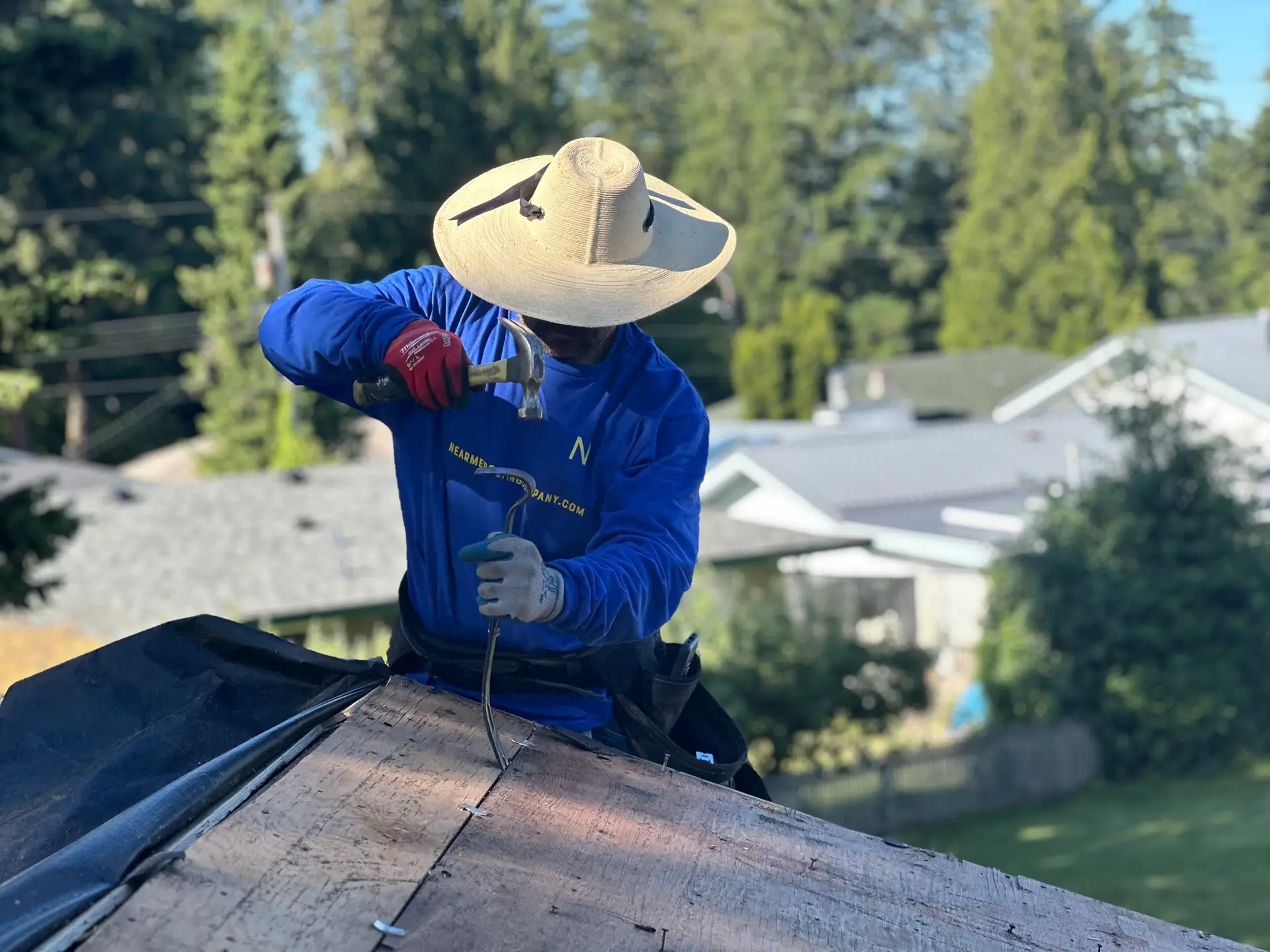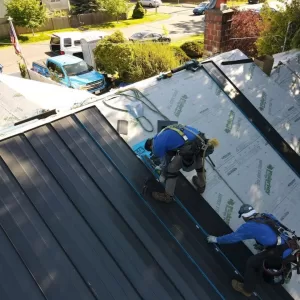Metal roofs protect homes from harsh weather, extreme temperatures, and seasonal challenges. But how long it provides that protection will ultimately depend on how well-maintained it is.
Each season brings unique challenges and whether you’re dealing with loose fasteners, minor corrosion, or drainage concerns, catching these issues early helps ensure your roof’s longevity. This guide walks you through essential metal roof maintenance tips for every season. You’ll learn what to look for during inspections, when to schedule professional maintenance, and how to get the best value for your metal roof.
Understanding Metal Roof Maintenance Basics
Metal roofs are typically very durable, but proper maintenance remains crucial for their performance. Your metal roof protects your home from weather extremes, structural stress, and moisture damage. We recommend regular inspections to catch potential issues early.
Why Metal Roofs Need Regular Maintenance
Professional roof inspections help identify small problems before they become major repairs. Your metal roof faces constant exposure to:
- UV radiation and heat
- Wind and rain
- Temperature fluctuations
- Environmental debris
Benefits of Proper Metal Roof Care
Quality maintenance delivers significant advantages for homeowners:
- Extended lifespan up to 40-70 years with proper care
- Prevention of costly repairs
- Better structural performance
- Enhanced curb appeal
- Early problem detection
Essential Maintenance Tools and Safety Equipment
Metal roof maintenance requires proper safety equipment and professional expertise. Falls represent the leading cause of construction-related fatalities according to OSHA. Professional roofers use:
- Personal Fall Arrest Systems (PFAS)
- High-quality safety harnesses
- Properly installed guardrails
- Slip-resistant footwear
- Emergency first aid supplies
Safety Warning: Metal roofs become extremely slippery when wet. We strongly recommend having qualified professionals handle your roof maintenance rather than attempting DIY repairs. Our trained technicians follow strict safety protocols and use specialized equipment for maintenance tasks.
Spring Maintenance Checklist
Spring signals the perfect time to assess how your metal roof weathered the winter months. Just as you inspect your car after a long winter, your roof needs a thorough check to ensure it’s ready for the times ahead.
Post-Winter Damage Assessment
Your metal roof faces unique challenges during winter. We recommend scheduling an inspection as soon as temperatures allow. Here’s what professional roofers examine:
- Loose or missing fasteners
- Early signs of rust or corrosion
- Seal integrity around vents and chimneys
- Panel alignment and connections
- Flashing condition
- Water damage indicators
Cleaning and Debris Removal
Accumulated debris can trap moisture against your metal roof, potentially leading to premature wear and corrosion. Your spring cleaning checklist should include:
- Remove leaves, branches, and winter debris
- Clean the roof surface with a gentle water spray
- Apply manufacturer-approved cleaners for tough spots
- Clear and flush gutters
- Test downspout drainage
Important Safety Note: Never use pressure washers on metal roofs as they will most likely damage the protective coatings and compromise seam integrity.
Addressing Winter Weather Damage
Winter’s freeze-thaw cycles can stress your metal roof. Trapped water becomes particularly problematic during cold months, as temperature changes cause material expansion and potential cracking.
Key inspection points include:
- Ice dam damage evaluation
- Wind-loosened panels
- Heavy snow accumulation areas
- Winter-stressed gutter systems
Proper ventilation helps prevent winter damage. Your attic needs balanced airflow to control moisture and temperature. While some maintenance tasks seem straightforward, others require professional expertise and safety equipment. When you’re unsure about your roof’s condition, contact NearMe Roofing Company for all your roofing maintenance needs in the Pacific Northwest area
Summer Maintenance Requirements
Summer heat brings special challenges for metal roofs. But how does intense sunlight and high temperatures affect your roof’s performance? Let’s explore the essential maintenance tasks that help protect your metal roof during the hottest months.
UV Protection and Heat Management
Think of your roof’s protective coating as sunscreen for your home. Metal roofs with proper protective coatings demonstrate excellent resistance to UV radiation and heat absorption. Regular coating inspections help ensure:
- Protection against rust and corrosion
- Color retention
- Reduced heat absorption
- Extended service life
Cool roof coatings reflect more sunlight and absorb less heat than standard roofs. Just like a light-colored car stays cooler in summer, these coatings help maintain comfortable indoor temperatures while reducing cooling costs.
Preventing Heat-Related Expansion Issues
Your metal roof expands and contracts with temperature changes, much like railroad tracks on a hot summer day. Different metals respond differently to heat, for example, Aluminum expands faster than steel. Our inspection process includes:
- Fastener tightness checks
- Panel alignment verification
- Joint spacing assessment
- Seam condition evaluation
At NearMe Roofing Company, we use specialized clips and fastening systems that accommodate thermal movement while maintaining structural integrity. This prevents warping and loose panels during intense summer heat.
Summer Storm Preparation
Summer storms test your roof’s strength. Just as you prepare your yard for storm season, your roof needs preparation too. We focus on reinforcing vulnerable areas, especially valleys and chimneys, to prevent storm damage.
Key inspection points include:
- Fastener security
- Panel alignment
- Penetration seals
- Drainage systems
Proper summer maintenance requires professional expertise and attention to detail. Ensure you schedule inspections before storm season peaks to prevent costly damage.
Fall Preparation Guidelines
Fall signals the time to prepare your metal roof for winter’s challenges. But how do you ensure your roof is ready for freezing temperatures, heavy snow, and ice formation? Let’s explore essential fall maintenance tasks that protect your investment.
Gutter and Drainage System Maintenance
Think of your gutters as your roof’s drainage highway – when leaves clog the road, water backs up and causes problems. Fall gutter maintenance prevents ice dams and water damage during winter. Your maintenance checklist should include:
- Clear leaves, twigs, and debris
- Flush gutters with water
- Repair loose connections
- Consider gutter guard installation
- Test downspout function
Pre-Winter Inspection Points
Fall’s mild temperatures create perfect conditions for roof repairs. At NearMe Roofing Company, we’d inspect and examine:
- Seam and joint tightness
- Flashing around vents and chimneys
- Sealant and coating condition
- Insulation and ventilation systems
- Early signs of rust or corrosion
Weatherproofing Techniques
Your metal roof needs proper weatherproofing before winter arrives. Just as you winterize your car, your roof needs preparation to handle freezing temperatures and moisture. Focus areas include:
- High-quality sealant application
- Ice dam prevention through proper insulation
- Roof penetration reinforcement
- Weatherproof coating verification
Balanced attic ventilation plays a crucial role in preventing ice dams and maintaining consistent roof temperature. Proper airflow helps prevent condensation that could lead to rust or mold growth.
Pay special attention to flashing around roof penetrations. These areas often face the greatest winter weather challenges. A thorough inspection now ensures your metal roof stands ready for winter’s arrival.
Remember that fall maintenance isn’t just about today’s protection – it’s about ensuring your roof performs throughout the coming winter months. Schedule your fall inspection early enough to complete necessary repairs before winter arrives.
Winter Care Strategies
Winter tests your metal roof’s strength and durability. But how do you protect your roof when temperatures drop below freezing and snow starts to pile up? Let’s explore essential winter maintenance strategies that help prevent costly repairs.
Snow and Ice Management
Your metal roof carries extra weight during winter. While metal roofs handle substantial snow loads well, proper management remains crucial. Professional roofers use specialized tools for safe snow removal:
- Plastic-edged roof rakes
- Long-handled snow removal tools
- Non-corrosive ice melt products
- Rubber-tipped shovels
- Safety harnesses and equipment
Safety Warning: Metal tools and sharp objects can damage your roof’s protective coating. Leave a thin snow layer rather than scraping the surface clean.
Preventing Ice Dam Formation
Think of ice dams like frozen waterfalls at your roof’s edge. When snow melts and refreezes, it creates barriers that trap water against your roof. Here’s how to prevent ice dam formation:
- Install proper attic insulation
- Maintain balanced ventilation
- Keep gutters clear
- Add heating cables where needed
- Ensure proper drainage
Professional Tip: Metal roofs shed snow efficiently, but still need protection against ice dams.
Emergency Winter Maintenance Tips
Winter storms can strike suddenly. While professional help should handle most repairs, watch for these warning signs:
- Unusual noises or ceiling stains
- Heavy snow buildup in valleys
- Ice accumulation in gutters
- Icicle formation
Important Safety Note: Icy metal roofs pose extreme dangers. Always call professionals for winter repairs.
Snow guards work like traffic barriers for your roof, breaking up snow and ice into manageable amounts. Strategic heating cable placement creates paths for melting snow to drain safely.
Remember, winter roof care requires professional expertise. Regular maintenance helps your metal roof defend against winter’s harshest conditions while protecting your home for years to come.
Conclusion
Your metal roof works hard every day to protect your home. But how do you ensure it continues performing at its best? Just as regular oil changes extend your car’s life, proper roof maintenance helps your metal roof serve your home for decades.
Think of seasonal maintenance as your roof’s preventive care plan. From spring’s post-winter checkups to winter’s snow management, each inspection and repair strengthens your roof’s defensive capabilities. Professional maintenance often makes the difference between a roof that needs replacement after 15 years and one that protects your home for over 50 years.
Remember, metal roof care requires specialized knowledge and proper safety equipment. While some home maintenance tasks suit DIY efforts, roof work demands professional expertise. Trust qualified contractors to keep your metal roof performing at its peak through every season, delivering the lasting protection your home deserves.
FAQs
How often should I perform maintenance on my metal roof?
Regular maintenance is crucial for metal roofs. Perform a thorough inspection at least once a year, with more frequent checks in extreme climates. Additionally, conduct a “light cleaning” annually and a “deep cleaning” every 3-5 years, depending on your location and environmental factors.
What are the main concerns with metal roofs?
The primary concerns for metal roofs include noise during rain or hailstorms, expansion and contraction due to temperature changes, potential for corrosion, denting from impacts, oil-canning (waviness in flat areas), chalking and fading of color, and susceptibility to scuffing and scratching.
How do I protect my metal roof during winter?
To protect your metal roof in winter, manage snow and ice accumulation using appropriate tools like plastic-edged roof rakes. Prevent ice dam formation by maintaining proper attic insulation and ventilation. Consider installing snow guards and heating cables for additional protection. Always prioritize safety and consider professional help for winter maintenance.
What should I include in my metal roof maintenance routine?
Your metal roof maintenance routine should include removing debris from the roof surface, valleys, and gutters; trimming overhanging branches; inspecting for damage, rust, or corrosion; repairing scratches; checking and replacing fasteners as needed; and ensuring proper drainage. Also, pay attention to the condition of sealants and protective coatings.
Can proper maintenance extend the lifespan of a metal roof?
Yes, proper maintenance can significantly extend the lifespan of a metal roof. With regular care and timely repairs, a well-maintained metal roof can last up to 50 years or more, compared to a neglected one that might need replacement in just 15 years. Regular professional inspections and maintenance are key to maximizing your roof’s longevity.





